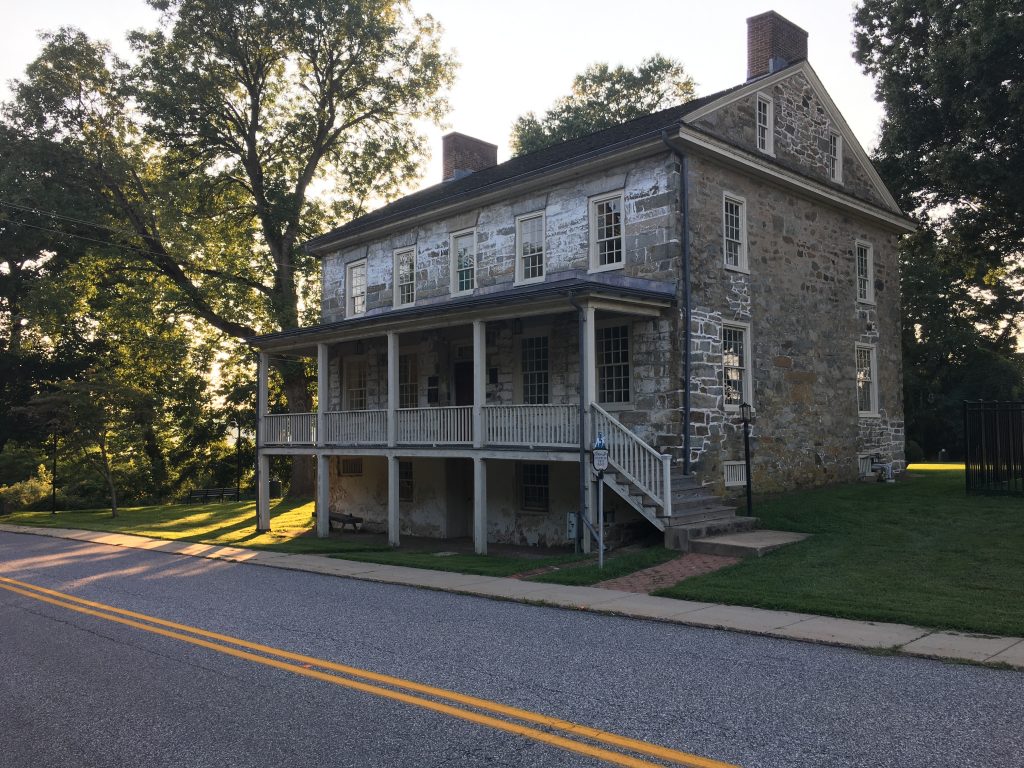Rodgers Tavern
I decided to make a stop this evening at a local historic site that I’ve read a bit about lately. It’s a place that has been at the center of the history of Perryville, MD for the last several centuries. Visiting somewhere like this and walking the grounds always has the effect of making it more real for me.

Rodgers Tavern gets its name from Col. John Rodgers who purchased it and another on the far bank of the Susquehanna River in Havre de Grace, in the 1780s. He also operated a ferry across the river between the two establishments. Located along the Old Post Road (also called the King’s Highway – the major north-south artery in 18th century America) it quickly became a popular stop for travelers.
Col. Rodgers gained fame as a commander in the Maryland militia early in the American Revolution, giving him ties to many notable figures of the day. George Washington was known to have slept here dozens of times – even once as he was travelling with the army to the final victory at Yorktown. Other revolutionary figures like Rochambeau and Lafayette also visited. Jefferson and Madison came through whenever they were travelling between Philadelphia or New York and their homes in Virginia.
It wasn’t just the visitors who were notable. Rodgers’ son (also named John Rodgers) who went on to become a Commodore in the United States Navy – perhaps the most important figure in the early history of that branch of our military, and a hero of the War of 1812 – was born in this building.
When the first railroad was constructed in the area, it paralleled the path of the Old Post Road. The Susquehanna River was seen as being too difficult to bridge, so a ferry remained in-place to carry the rail traffic. Passengers would exit the train in either Perryville or Havre de Grace and walk down a pier to a waiting ferry boat that would carry them and their baggage to the far shore where another train would complete the trip to their destination. The tavern thus remained a popular stop along the route of the Philadelphia, Wilmington, and Baltimore Railroad well into the 19th century.
A young Abraham Lincoln was known to have been a passenger on this route during his days in Congress. Robert E. Lee also passed through on several occasions as he traveled between Baltimore (where he was assigned to supervise the construction of Fort Carroll) and West Point (where his son was studying). Eventually, Lee would make the same trip to West Point to take over as its Superintendent. Another future Confederate General, Isaac Trimble, was the Chief Engineer of the PW&B for many years, and must have come past this building constantly.
The first Union troops to arrive in Washington from the north in preparation for the Civil War passed through here on the PW&B. It was these soldiers who were involved in the Baltimore Riots, causing the next wave under the command of Gen. Benjamin Butler, to get off the trains here and continue south to Annapolis by boat.
The tavern and ferry were bypassed once a railroad bridge was constructed here in 1866. Within two decades, it was effectively abandoned.
But before the bridge changed history, my favorite passenger came through – a man who was much more anonymous at the time he was traveling. In fact, he was trying very hard to blend into the crowd, carrying forged papers, and attempting to avoid the constables who were always on the prowl for run-aways. Luckily, a young Frederick Douglass got off the ferry at Perryville and walked right in front of this tavern on his way to freedom on September 3, 1838. Can you imagine the mix of emotions that he must have felt at that moment in this place?
That is the value of historic preservation. Being in this place – having a tangible connection to these events and the people who lived them – makes history (and thus the human experience) so vivid. Go out and find amazing experiences like this for yourself!
This post was inspired by some books on local history that I’ve been reading recently, most notably:
- “This Trying Hour: The Philadelphia, Wilmington, and Baltimore Railroad in the Civil War” by Scott L. Mingus, Sr. and Robert L. Williams, Createspace Independent Publishing, 2017
- “Maryland’s Lower Susquehanna River Valley: Where the River Meets the Bay” by David A. Berry, History Press (SC), 2009